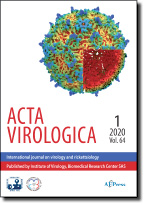Acta Virologica Vol.55, No.3, p.195-202, 2011
|
| Title: Analysis of antigen epitopes and molecular pathogenic characteristics of the 2009 H1N1 pandemic influenza A virus in China |
| Author: J. J. ZHOU, J. TIAN, D. Y. FANG, Y. LIANG, H. J. YAN, J. M. ZHOU, H. L. GAO, C. Y. FU, Y. LIU, H. Z. NI, C. W. KE, L. F. JIANG |
|
Abstract: In order to further predict the epidemic trend and develop vaccines for 2009 H1N1 virus, we monitored its epitopes and molecular pathogenic characteristics during the epidemic process. We also analyzed the similarity of antigenic and genetic characteristics among the novel 2009 H1N1, representative seasonal H1N1 strains, and vaccine strains. 2009 H1N1 isolates had high similarity of hemagglutinin (HA) antigenic sites with H1N1 viruses isolated before 1940 and up to 80.0% similarity with 1918 H1N1. The elderly people born before 1940 have relatively low 2009 H1N1 infection rate, which might be responsible for their previous infection with either 1918 H1N1 virus or an early progeny. Compared to seasonal H1N1 vaccine strains from 1999 to 2010, the HA, neuraminidase (NA), and nucleoprotein (NP) proteins of the isolates had highly conserved CTL epitopes (60.5–65.8%, 69.6–82.6%, and 76.7%, respectively). The seriousness and mortality rate of 2009 H1N1 infections were similar to seasonal influenza, which may be related to the molecular characteristics of low toxicity of 2009 H1N1 and cross-T-cell immunity, due to vaccination or exposure to seasonal H1N1 virus. Some strains of 2009 H1N1 acquired mutations at antigenic and glycosylation sites. It is of particular interest that Haishu/SWL110/10 and Beijing/SE2649/09, isolated after November 2009, gained a new glycosylation site at the position 179 of HA protein, near the RBD. Thus, in the future, vaccination with glycosylated 2009 H1N1 virus may prevent the seasonal epidemic caused by strains with glycosylation site mutation near the receptor binding domain (RBD).
|
|
| Keywords: antigen epitope; glycosylation site; influenza A virus; 2009 H1N1 |
|
|
|
| Year: 2011, Volume: 55, Issue: 3 |
Page From: 195, Page To: 202 |
doi:10.4149/av_2011_03_195
|
Price:
16.00 €
|
|
|
|
|
|
|
|

